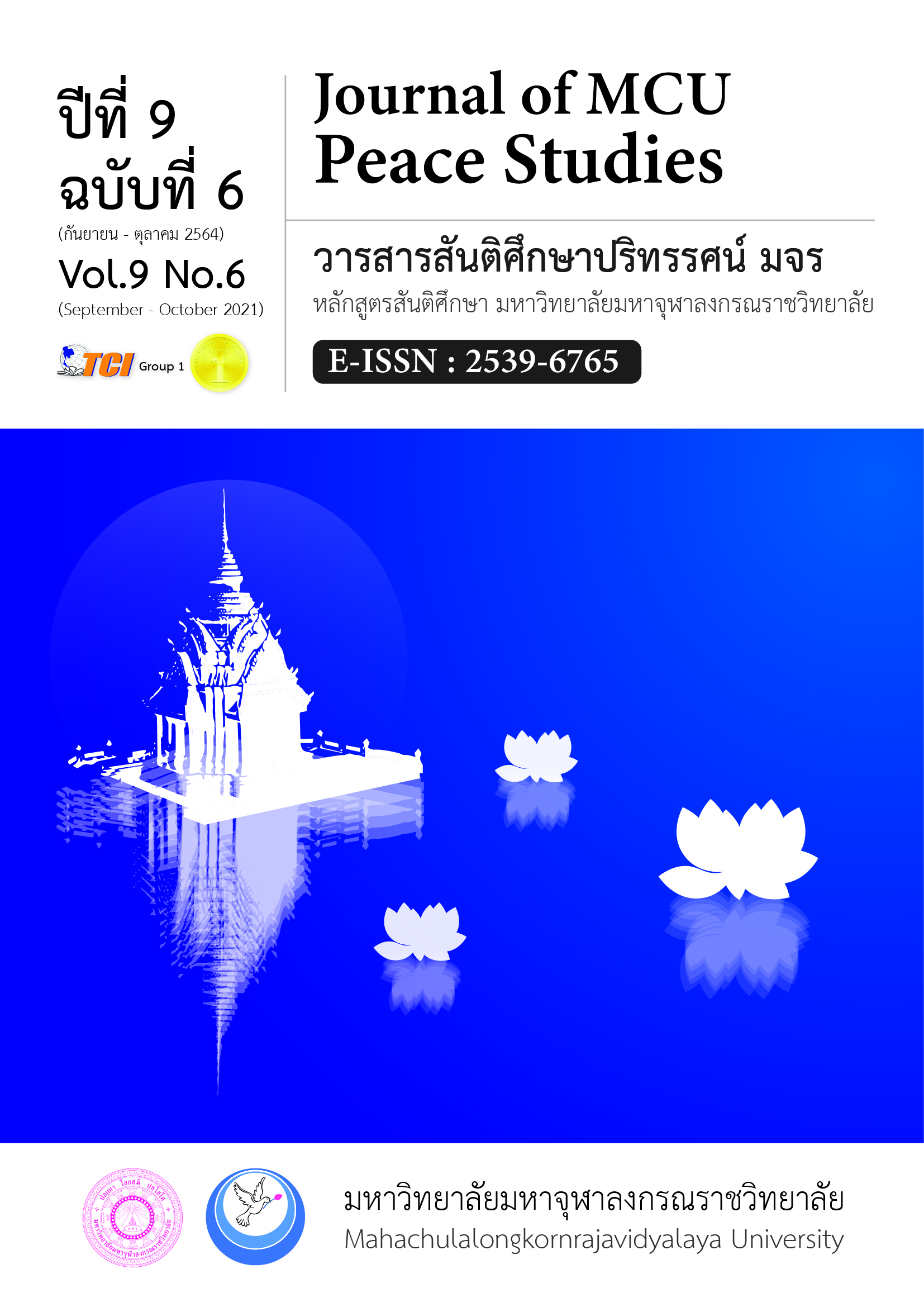ผลของอานาปานสติกัมมัฏฐานในผู้ป่วยที่ได้รับการฟอกเลือดด้วยเครื่องไตเทียม
Main Article Content
บทคัดย่อ
บทความวิจัยนี้ มีวัตถุประสงค์หลักคือ เพื่อศึกษาผลของอานาปานสติกัมมัฏฐานในผู้ป่วยที่ได้รับการฟอกเลือดด้วยเครื่องไตเทียมต่อภาวะสมองเสื่อม ต่อคุณภาพชีวิต และต่อความซึมเศร้า วัตถุประสงค์รองคือ เพื่อศึกษาผลลือด และผลของสัญญาณชีพหลังการทำอานาปานสติกัมมัฏฐาน การวิจัยนี้เป็นการวิจัยกึ่งทดลอง ผู้วิจัยได้รวมรวมผู้ป่วยโรคไตเรื้อรังที่ได้รับการรักษาด้วยการฟอกเลือดด้วยเครื่องไตเทียม 3 ครั้งต่อสัปดาห์ จำนวน 36 คน โดยได้ให้ผู้ป่วย ทำการสวดมนต์ร่วมกับการทำอานาปานสติกัมมัฏฐาน เป็นเวลา 35 นาทีทุกครั้งที่ผู้ป่วยมาฟอกเลือด นาน 12 สัปดาห์ ที่ เค.พี.เอส.การแพทย์คลินิกเวชกรรมเฉพาะทางโรคไต กรุงเทพมหานคร การวิเคราะห์ข้อมูล: ผู้วิจัยวิเคราะห์ภาวะสมองเสื่อมด้วย Montreal Cognitive Assessment (MoCA) ประเมินคุณภาพชีวิตด้วย SF-36 และ ประเมินภาวะซึมเศร้าด้วย Thai Depression Inventory Score (TDI) วิเคราะห์ผลเลือดพื้นฐานต่าง ๆ และค่าเฉลี่ยของชีพจร ของผู้ป่วยที่ได้รับการฟอกเลือดที่เข้าร่วมการทดลอง โดยใช้สถิติเชิงอนุมาน ได้แก่ค่าเฉลี่ยเลขคณิต (Mean) ค่าส่วนเบี่ยงเบนมาตรฐาน (Standard Deviation = SD) การวิเคราะห์ค่านัยสำคัญทางสถิติโดยใช้ t-test ผลการวิจัย ตามลำดับของวัตถุประสงค์หลัก และวัตถุประสงค์รอง 1) ผลประเมินภาวะสมองเสื่อม ผลการประเมินคุณภาพชีวิต และผลการประเมินภาวะซึมเศร้าของผู้ป่วยที่ได้รับการฟอกเลือดที่เข้าร่วมการทดลอง ดีขึ้นทั้งหมดอย่างมีนัยสำคัญทางสถิติ 2) ผลประเมินค่าของเสียในเลือด BUN และผลของอัตราการหายใจของผู้ป่วยที่ได้รับการฟอกเลือดที่เข้าร่วมการทดลองดีขึ้นทั้งหมดอย่างมีนัยสำคัญทางสถิติ
Article Details
ทัศนะและความคิดเห็นที่ปรากฏในบทความในวารสาร ถือเป็นความรับผิดชอบของผู้เขียนบทความนั้น และไม่ถือเป็นทัศนะและความรับผิดชอบของกองบรรณาธิการ ยินยอมว่าบทความเป็นลิขสิทธิ์ของวารสาร
เอกสารอ้างอิง
Ansgar, C. et al. (2007). Psychophysiological effects of breathing instructions for stress management. Applied Psychophysiology and Biofeedback, 32(2), 89-98.
Bantornwan, S. et al. (2014). Role Of Meditation in Reducing Sympathetic Hyperactivity and Improving Quality of Life in Lupus Nephritis Patients with Chronic Kidney Disease. Journal of Medicine Associate Thai, 97(3), S101-S107.
Cahn, B., & Polich, J. (2010). Meditation (Vipassana) and The P3a Event-Related Brain Potential. International Journal of Psychophysiology, 72(1), 51–60.
Chan, C. T. et al. (2019). Dialysis Initiation, Modality Choice, Access, And Prescription: Conclusions from A Kidney Disease: Improving Global Outcomes (KDIGO) Controversies Conference. Kidney International, 96(1), 37-47.
Kalirao, P. et al. (2011). Cognitive Impairment in Peritoneal Dialysis Patient. American Journal of Kidney Disease, 57(4), 612–620.
Krittayaphong, R. et al. (2000) . Reliability of Thai Version of SF-36 Questionnaire for The Evaluation of Quality of Life in Cardiac Patients. Journal of the Medical Association of Thailand, 83(2), S130-S136.
Lewington, S. et al. (2002). Age-Specific Relevance of Usual Blood Pressure to Vascular Mortality: A Meta-Analysis of Individual Data for One Million Adults in 61 Prospective Studies. Lancet, 360(9349), 1903–1913.
Lotrakul, M., & Sukanich, P. (1999). Development of the Thai Depression Inventory. Journal of the Medical Association of Thailand, 82(12), 1200-1207.
Mahachulalongkornrajavidyalaya University. (1996). Thai Tipitakas. Bangkok: MCU Press.
Mrazek M., Franklin M., & Phillips, D. T. (2013). Mindfulness Training Improves Working Memory Capacity and GRE Performance While Reducing Mind Wandering. Journal of Psychological Science, 24(5), 776–781.
Oberg, E.B., Rempe, M., & Bradley, R. (2013). Self-directed Mindfulness Training and Improvement in Blood Pressure, Migraine Frequency, and Quality of Life. Global Advances in Health and Medicine, 2(2), 20-25.
Phairatwet, P. et al. (2021). The Effect of Dhamma Practice on Depression Outcomes in Hemodialysis Patients. Journal of the Medical Association of Thailand, 104(1), 44-51.
Seki, M. et al. (2019). Blood Urea Nitrogen is Independently Associated wth Renal Outcomes in Japanese Patients with Stage 3 – 5 Chronic Kidney Disease: A Prospective Observational Study. BMC Nephrology, 20(1), 115.
Thailand Renal Therapy Subcommittee: Nephrology Society of Thailand. (2019) Thailand Renal Replacement Therapy Year 2016-2019. Bangkok: The Nephrology Society of Thailand.
Vandana,B. et al. (2011). Impact of Integrated Amrita Meditation Technique on Adrenaline and Cortisol Levels in Healthy Volunteers. Evidence-Based Complementary and Alternative Medicine, 2011(3479), 379645.
Vareesangthip, J. (2010). The Improvement of The Quality of Life of The End Stage Renal Disease Patients by Dhamma Practice. Bangkok: Amy Enterprise Company Limited.
Vareesangthip, J. et al. (2016). A Study of the Effect of Ānāpānassati Kammaṭṭhāna on the Quality of Life in Continuous Ambulatory Peritoneal Dialysis Patients. Journal of Graduate Studies Review, 12(3), 31-44.
Wimmer, L. et al. (2016). Cognitive Effects of Mindfulness Training: Results of a Pilot Study Based on a Theory Driven Approach. Frontiers in Psychology, 12(7), 1037.


